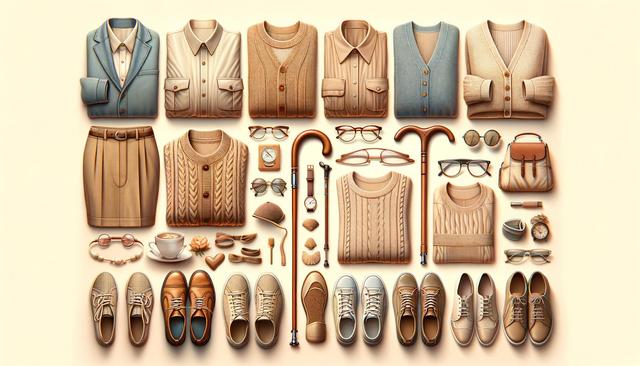Prioritizing Comfort Without Sacrificing Style
As we age, comfort becomes an essential part of our wardrobe decisions. Seniors, especially those receiving assisted in home care or living in senior assisted living care communities, benefit from clothing that feels good and is easy to wear. However, comfort doesn’t mean compromising on style. Soft, breathable fabrics such as cotton, bamboo, and modal blends are excellent choices for daily wear. These materials reduce skin irritation and are easy to maintain, making them ideal for elder care in home assistance settings.
When selecting clothing, consider features like:
- Elastic waistbands for ease and flexibility
- Velcro closures instead of buttons or zippers
- Slip-on shoes with non-slip soles
- Layered clothing to adjust to changing temperatures
Assisted senior care often includes support with dressing, so choosing garments that are simple to put on and take off helps caregivers and supports seniors’ independence. Many people searching for “assisted home care near me” or “assisted senior care near me” are also looking for lifestyle support that includes such practical clothing tips.
Choosing Clothes That Boost Confidence
Feeling good in your clothing can significantly enhance a senior’s self-esteem. Many seniors, even those living in assisted living senior care environments, enjoy expressing their personality through fashion. Whether it’s a favorite color, a signature scarf, or a classic cardigan, clothing can be an important outlet for self-expression. Encouraging seniors to continue wearing their preferred styles, adapted for their current needs, promotes dignity and confidence.
Simple tips to maintain personal style include:
- Choosing favorite colors or patterns
- Accessorizing with lightweight jewelry or scarves
- Maintaining personal grooming and neat hairstyles
When families explore options like “senior care assisted living” or “assisted senior care near me,” it’s important to remember that fashion and personal grooming are part of holistic care. These details, while seemingly small, contribute to emotional well-being and daily satisfaction.
Adapting Wardrobes for Changing Needs
Mobility issues, arthritis, and other health concerns often require changes in how seniors dress. When seeking “assisted senior care” or transitioning into “assisted living senior care,” it’s important to reevaluate clothing choices to ensure they meet new mobility and dexterity requirements. Adaptive clothing lines are specifically designed to address these needs, offering stylish alternatives that are easier to manage.
Look for clothing that features:
- Side or back openings
- Open-back tops for wheelchair users
- Magnetic closures
- Tagless labels to reduce skin irritation
These adaptations are especially helpful for seniors who receive help from caregivers or those in elder care in home assistance programs. As you explore options like “assisted home care near me,” it’s worth discussing clothing adaptations with care providers to ensure the senior’s comfort and dignity are upheld.
Seasonal Considerations and Safety
As seasons change, so should your wardrobe. For seniors, dressing appropriately for the weather is essential not just for comfort but also for safety. Those in assisted in home care or senior assisted living care benefit from seasonal wardrobe planning that helps regulate body temperature and prevent health issues such as overheating or chills.
Consider these seasonal wardrobe tips:
- Layering in colder months with thermal undershirts and lightweight sweaters
- Light, loose-fitting clothing in breathable fabrics for summer
- Hats and sunglasses for sun protection
- Non-slip socks and shoes for icy or wet conditions
Caregivers and family members looking for “assisted senior care near me” should ensure that the wardrobe includes items suitable for each season. Proper clothing not only supports health but also permits seniors to continue participating in outdoor or communal activities safely and comfortably.
Involving Seniors in Style Decisions
Fashion choices should always reflect the preferences and identities of the individuals wearing them. Even in assisted living senior care environments, seniors should be included in decisions about their wardrobe. This inclusion promotes autonomy and helps maintain a sense of control over daily life, which is crucial for emotional well-being.
Here are ways to involve seniors in fashion decisions:
- Letting them choose colors or patterns during shopping trips
- Organizing seasonal wardrobe reviews together
- Encouraging input on accessories or special occasion outfits
Whether you’re evaluating “assisted home care near me” or planning for ongoing care, it’s important to remember that fashion is not only functional but also deeply personal. Respecting and supporting seniors’ choices contributes to a more fulfilling assisted senior care experience.
Conclusion: Fashion as a Form of Self-Care in Senior Living
Dressing with comfort and style is more than just a daily routine—it’s a meaningful aspect of self-care for seniors. From choosing adaptive clothing to involving seniors in wardrobe decisions, fashion can be a source of confidence, safety, and joy. Whether receiving elder care in home assistance or living in a senior care assisted living community, thoughtful clothing choices support independence and well-being. As you explore options like “assisted senior care near me” or “assisted living senior care,” remember that a well-considered wardrobe can make a significant difference in a senior’s quality of life.







